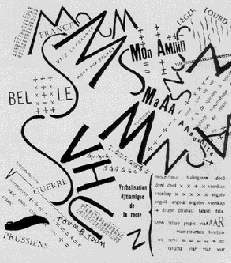
Filippo Tommaso Marinetti, After the Marne,
Joffre Visited the Front ofan Automobile, 1915,
in Les Mots en liberta futuristes (1919).
Beinecke Library, Yale University, New Haven, Connecticut.

Among the best known in this regard is the Italian Futurist Filippo Tommaso Marinetti, who created, in late 1913 to early 1914, a poetic form he called parole in liberte (words in freedom).
Central to Futurism's philosophy was the destruction of cultural tradition through the annihilation of past symbols and conventions, in order to allow a new art form to emerge from the ashes. Founded on an aesthetic of modern warfare and techno logy, Futurism celebrated speed, motion, violence, and noise. Realized as collages, Marinetti's poems are dissonant compositions with nonsense words in various typefaces and sizes meandering freely about the page, resulting in a chaotic patt ern of forms. He distorted, stretched, and fragmented words, so that they lost all connection to their original meaning.
Marinetti hoped that the pure force of the words sounds given visual expression through their arrangement on the page would result in a more primitive and hence, he believed, more original form of communication.
The Museum of Non-Objective PaintingAbstraction in the Twentieth Century
Abstraction in:
Photography